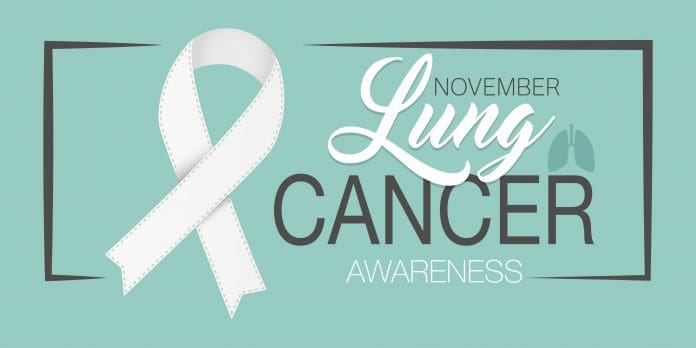November is Lung Cancer Awareness Month. In honor of my late father, I
wanted to take the time to share some stories, statistics and facts hopefully
to help someone out there. On November 2, 2018, I was told that my dad’s stage 4
cancer had stopped spreading. Crazy enough, that was the original wedding date
Jonathan and I had picked out. We ended up moving it to November 1, 2019 to
focus on my dad’s recovery. My dad stopped the last of this chemo treatment in
June due to how it was making him feel. Now, I don’t know if the cancer really
stopped spreading of that’s what they told me because they knew he didn’t have
a lot of time life. On February 27, 2019 he took his last breath.
It was an incredibly tough 5 years dealing with his many illnesses, but
the last 3 years of his life were extremely rough. Watching his body deteriorate
from heart disease, lung cancer and all the chemo. My father and his best friend
both died of stage 4 lung cancer. One smoked for 40+ years and the other didn’t
smoke a day in his life. They both had very different stories, one fought for 3+
years, one for 3 months. Doctors haven’t able to always explain how one person
can develop lung cancer and the other doesn’t. But research has shown that the
following risk factors can increase an individual’s chance of developing lung
cancer:
- Tobacco smoke: the most common cause of lung
cancer. 80-90% of those diagnosed with lung cancer are either current or former
smokers with the remainder having never smoked. This includes secondhand smoke!
Smokers are hurting more than themselves as their smoking can damage the people
they love and care about.
- Radon: is a radioactive gas that
comes from the breakdown of uranium in soil, rock and water. You cannot smell,
taste or even see it. Scary right? Radon is the second most common cause of lung
cancer. Well, how do you fight it if you can’t see it? The US Environmental
Protection Agency (EPA) suggests getting your homes tested. The process is easy,
affordable and only takes a few minutes to set up (results take more time). You can get a test kit from your local
hardware store, online or can have a qualified tester perform the test for you.
- Asbestos & carcinogens: some professions (especially in construction or chemical industries) have a
higher exposure to these substances due to the nature of the job. Check with
your doctor often to make sure everything is clear.
- Air pollution: this includes outdoor
and indoor air pollution. Indoor pollution includes those who use kerosene fuel,
coal and biomass to heat up their home.
- Family or personal history of
lung cancer – this is more related to similar exposure as the one who was diagnosed
with lung cancer rather than genetics (like secondhand smoke).
- Radiation therapy: sadly trying
to cure another cancer can create a new cancer. It may take years to develop,
so keep checking in with your doctors.
Lung Cancer Statistics
- Two-thirds of those diagnosed
with lung cancer are 65 and older.
- Lung and bronchus cancer are
the leading cause of death by cancer in the US.
- The 5-year survival rate for
lung cancer patients is 18.6% (colorectal 64.5%, breast 89.6%, prostate 98.2%).
- The 5-year survival rate for
lung cancer is 56% for cases diagnosed while the disease is still localized (in
the lungs).
- 16% of lung cancer cases is detected
and diagnosed at an early stage.
- More than half of those with
lung cancer die within a year of being diagnosed.
Symptoms to Look Out For
- A cough that gets worse or
does not go away
- Coughing up blood
- Chest symptoms
- Trouble breathing, such as
shortness of breath
- New wheezing when you breathe
- Ache or pain in your chest,
upper back, or shoulder that doesn’t go away and may get worse with deep
breathing
- A hoarse voice
- Frequent respiratory tract
infections, such as pneumonia or bronchitis
- General physical symptoms
- Feeling unusually tired all
the time
- Weight loss with no known
cause and loss of appetite
- Trouble swallowing
- Swelling in the face and/or
veins in the neck
Lung cancer can also spread and cause pain in the back or other bones
or weakness in the arms or legs. Which is what happened to my dad. The cancer had
spread and wrapped around my dad’s spine causing temporary paralysis and lots
of discomfort and back pain to the point where he could no longer walk. I’m not
sharing my story to make you feel bad for me. I’m telling it because I want
people to be aware of the dangers of smoking. With all the studies out there,
smoking has gone down but vaping has been introduced within the last few years
and new users are rising every single day.
I don’t know enough about vaping to say much about it, but I know it
can’t be good. It took us a very long time to learn about the dangers of
smoking and for some it’s too late. Please share this information to anyone you
think may need it. If you need someone to talk to, you can email me at labouroflovecrafts@outlook.com.
You’re not alone.
Resources:
A Citizens Guide to Radon: https://www.epa.gov/sites/production/files/2016-12/documents/2016_a_citizens_guide_to_radon.pdf





























